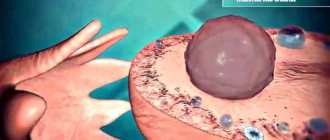Salpingoophoritis, or adnexitis, is an inflammatory process in the ovaries, fallopian tubes or uterus. Doctors are categorical in their assertion that in the acute form, pregnancy cannot occur, and if conception suddenly occurs, this is fraught with very serious complications for the mother and child. Therefore, if a woman with such a pathology plans to have a healthy child, she needs to undergo a full course of treatment in preparation for conception.
Salpingoophoritis: general information, stages and types
General information about salpingoophoritis
Salpingo-oophoritis or adnexitis is commonly called inflammation in the fallopian tubes and ovaries. Appendages belong to the internal genital organs of a woman:
- The fallopian tubes;
- Ovaries;
- Ligaments.
Inflammatory processes in the fallopian tubes are usually called salpingitis, and in the ovaries - oophoritis. Due to the undeniable connection, common blood flow, inflammation occurs in both the tubes and the ovaries. It is for this reason that the disease was called salpingoophoritis, combining two ailments.
The disease is quite common. Most often, this diagnosis occurs in women of childbearing age who are actively sexually active. According to the nature of the disease, they are distinguished:
- Acute (from 2 weeks);
- Subacute (more than 1 month);
- Chronic (more than 2 months).
By location:
- Bilateral (both sides are affected);
- Left-sided (inflammation in the left appendage);
- Right-sided (inflammation in the right appendage).
The disease itself can be treated quite simply, provided that the patient immediately contacts the antenatal clinic and follows all instructions and recommendations. In the absence of proper monitoring and assistance, irreversible processes can develop, including infertility.
Classification
Salpingoophoritis can be specific and nonspecific. In the first case, the disease develops as a result of infection of the reproductive organs by microorganisms that have entered the body from the outside - herpes virus, chlamydia, gonococcus, trichomonas, mycoplasma, and so on. In the second case, the own microflora that populates the vagina is activated.
The disease can be unilateral or bilateral. With unilateral salpingoophoritis, the pathological process is localized on the left or right, with the left-sided form being more common.
Reference! If only one tube is affected, pregnancy during the disease is possible.
Based on the nature of the course, there are 3 forms of the disease:
- Spicy. The pathological process begins in the tubes, and then the pathological flora penetrates the ovary. A large amount of inflammatory fluid begins to be released into the lumen of the fallopian tubes, so the woman may feel pain. In addition, a large amount of liquid can provoke suppuration. Depending on how severely the tissue is affected, the acute form of the disease may be accompanied by symptoms of irritated peritoneum, rupture of the tubo-oval formation, and blockage of the fallopian tubes.
- Subacute. When the pathology first occurs, the symptoms will be less pronounced. Subacute salpingoophoritis is not accompanied by severe pain; most often, patients complain of a dull, aching sensation. Pain in the subacute form of the disease does not have a clear localization and can be observed in different parts of the abdomen.
- Chronic. If the acute form of the pathology was not treated, or was treated incorrectly, a chronic form develops. This pathology leads to the formation of adhesions inside the fallopian tubes, as a result of which their patency is impaired and pregnancy becomes difficult. The chronic course of salpingoophoritis is characterized by a long course, periodic relapses, and menstrual irregularities.
Causes of inflammation of the uterine appendages
Statistics show that in a significant proportion of women, salpingoophoritis occurs precisely because of the presence of infectious microorganisms in the cavities of the fallopian tubes and ovaries. In addition to infections, the general condition of the body plays a decisive role. Weakened immunity and infectious diseases are a catalyst for bacteria and viruses that cause salpingoophoritis.
Infection can penetrate the uterine appendages in various ways:
- From the vagina and uterine cavity;
- From the localization of another source of infection along with blood;
- Through the lymphatic system.
The first way is the most common. Most often, a combination of several bacteria present in the vaginal microflora can cause severe inflammation in the appendage area. The main provoking factors of inflammation include:
- Overwork and stress;
- Unbalanced diet;
- Infectious diseases;
- Hypothermia;
- Surgical abortion;
- Curettage of the uterus;
- Intrauterine device;
- Sexual intercourse without the use of barrier contraceptives;
- Failure to comply with personal hygiene rules;
- Frequent douching.
As mentioned earlier, the most likely cause of the disease is sexually transmitted infections. Salpingo-oophoritis does not manifest itself in any way in the first stages, so the disease often becomes chronic.
Diagnostics
You need to be examined by a specialist if you suspect salpingoophoritis. The examination during pregnancy is carried out as carefully as possible so as not to harm the unborn child. Using a two-manual (bimanual) examination, the diagnosis and treatment options can be determined.
If there is a suspicion of a disease in the expectant mother, the gynecologist takes material for examination, which is collected from the vagina, cervical canal and urethra using an instrument. They study it using a microscope.
The disease can be determined using ultrasound diagnostics (ultrasound). It is also possible to use magnetic resonance imaging (MRI), but it should not be done for pregnant women.
Symptoms indicating the onset of the inflammatory process
The symptoms and course of the disease directly depend on the pathogen and the duration of inflammation. It is worth noting that the types of salpingoophoritis manifest themselves differently. With the acute and subacute nature of the disease, the following symptoms occur:
- Periodic increase in body temperature;
- General weakness of the body;
- Drowsiness;
- Painful sensations in the lower abdomen (pulling, shooting);
- Pain when urinating;
- Diarrhea;
- Nausea;
- Purulent vaginal discharge with an unpleasant odor.
Symptoms of inflammation in the pelvic area
The localization of pain directly depends on the location of the inflammation (right/left side). With bilateral salpingoophoritis, pain throughout the entire abdominal area is characteristic. If purulent stagnation occurs in the uterine tubes, the woman’s well-being deteriorates significantly. Most likely, a significant increase in body temperature, as well as unbearable pain in the lower abdomen. In this case, you must immediately seek help from a medical facility.
Dangerous complications
Exacerbation of salpingoophoritis most often occurs due to re-infection or non-serious attitude to the doctor’s recommendations. At the acute stage, the following complications are possible:
- Localization of pus in the cavities of the tubes or uterus;
- Progression of the disease to the chronic stage.
A purulent abscess of the tubes and ovaries is fraught with intoxication of the body. In the absence of proper treatment, a woman’s life-threatening situation develops. Moreover, the infection can spread to the body's urinary system all the way to the kidneys. Unilateral inflammation significantly reduces the likelihood of conception, and bilateral adnexitis, complicated by bilateral inflammation, leads to infertility.
Complications of the chronic form of the disease are dangerous due to irreversible anatomical changes:
- Injuries to the mucous tissue of the fallopian tubes;
- Impaired patency of the fallopian tubes due to the formation of exudate;
- Formation of adhesions.
All these dangerous changes lead to the fact that a woman cannot conceive and bear a child. In addition, the adhesive process with nearby organs disrupts their function.
With all the listed complications, it is not difficult to guess that chronic salpingoophoritis significantly worsens the quality of life and leads to neurosis.
How is it going?
If we imagine that conception has occurred, how will adnexitis during pregnancy affect the condition of the fetus? Even if the altered endometrium did not prevent the fertilized egg from attaching, it may still be susceptible to a number of threats:
- As a result of impaired microcirculation in the endometrium, the fetus does not receive enough nutrition, resulting in frozen pregnancy and miscarriage;
- Miscarriage as a result of hypertension, at any time;
- The spread of the inflammatory process to the fetus, and as a result, its death.
In addition, as mentioned above, there is a high probability of ectopic pregnancy due to low patency of the tubes. And besides, chronic salpingoophoritis at the onset of conception may well become acute.
Treatment of adnexitis
This disease is strongly recommended to be treated in a hospital setting. There are several basic techniques used in the fight against adnexitis:
- After identifying the pathogen, antibiotic treatment is prescribed. In some cases, several drugs from this group are prescribed at once.
- Intensive detoxification therapy.
- Anti-inflammatory and painkillers.
- Antihistamines.
- Immunostimulants.
- Local treatment.
After the process has stabilized, additional physiotherapeutic procedures may be prescribed. It is noteworthy that chronic adnexitis, unlike acute adnexitis, often shows a weak effect from antibiotics. In this case, the following methods are appropriate:
- Physiotherapy;
- Use of anti-inflammatory drugs;
- Prescription of immunostimulating drugs;
- Treatment in a sanatorium, but not in a hot and humid climate.
But there are cases of advanced disease that threatens a woman’s life. Under such circumstances, conservative treatment methods are powerless, and the problem can only be solved through surgical intervention.
Surgical methods of treatment and correction
Before deciding on surgical intervention, the doctor is obliged to thoroughly study the medical history and come to the conclusion that surgical treatment of salpingoophoritis is the only way out. Conditions for surgery:
- purulent neoplasms on the appendages;
- suspicion of a malignant tumor;
- formation of adhesions;
- severe cutting pain in the lower abdomen;
- frequent exacerbations of the disease;
- infertility;
- endometriosis in combination with salpingoophoritis.
Whenever possible, young women are trying to preserve their reproductive function. Laparoscopy is used for accurate diagnosis. It allows you to examine the fallopian tubes and ovaries in more detail, and confirm or refute the diagnosis. This procedure checks for the presence of adhesions, purulent formations, inflammatory processes, and changes in the structure of organs. A procedure called “laparotomy” is prescribed if the ovaries or fallopian tubes rupture due to purulent formations and inflammation.
Alternative medicine in the fight against inflammation
Salpingoophoritis is a serious disease with dangerous consequences. As mentioned earlier, neglecting advice and ignoring treatment and doctors’ recommendations is unwise. There are many recipes from traditional medicine. But it should be remembered that they can only remove some of the symptoms, but cannot cure the disease. It is strongly recommended to consult a doctor before use.
In alternative medicine, the following recipes are distinguished:
- Drink potato juice before meals. To obtain it, peeled potatoes are grated on a fine grater and squeezed. For taste, it is recommended to mix it with carrot juice. Before use, stir the liquid thoroughly.
- Flowers of cornflower, clematis and tenacious are poured with a liter of boiling water. Boil for 10 minutes and leave overnight. It is recommended to drink the infusion before meals, 4 times a day.
- Brew coltsfoot flowers. Leave for 1 hour. Strain the broth and drink 100 g. 2 times a day.
- Mix rose hips and currants, pour boiling water over them and let it brew. If desired, you can add sugar or honey. Use the decoction throughout the day.
- Pharmaceutical chamomile is poured with boiling water. Let it brew and cool to body temperature. Douche with chamomile solution once a day before bed.
Be careful! Uncontrolled use of traditional medicine can not only alleviate symptoms, but also provoke complications. That is why it is not recommended to self-medicate and seek adequate help from an antenatal clinic.
Disease prevention
In order to avoid a disease such as chronic salpingoophoritis, it is enough to follow some rules:
- Avoid promiscuity;
- Use barrier contraceptives such as condoms;
- Do not use douching unless prescribed by a doctor. It disrupts the natural microflora of the vagina;
- Observe the rules of personal hygiene: use only your own things and clothing;
- It is better to prevent pregnancy than to have an abortion;
- At least twice a year it is necessary to undergo examination with a partner;
- Eat a balanced diet;
- Don't get too cold and dress for the season.
In conclusion, we note that salpingoophoritis or adnexitis is a quite serious disease, and treatment methods are most often harsh and lengthy. Therefore, we strongly recommend that you adhere to simple rules and wish you good health!
Salpingo-oophoritis or adnexitis - inflammation of the appendages:
See also:
- Chronic inflammation of the appendages
- Inflammation of the pelvic organs in women
- Nagging pain in the abdomen - causes
- Inflammation of the uterus: symptoms, treatment, prevention
- Antibiotics for the treatment of inflammation in women
- Inflammation of the ovaries. How to treat ovarian inflammation?
- Symptoms of inflammation of the ovaries and appendages, acute and chronic adnexitis
- Chlamydia chronic
- Fluid accumulation in the fallopian tubes: what to watch out for
(No Ratings Yet)
About the author: Natalya MirBodrosti
« Previous entry











